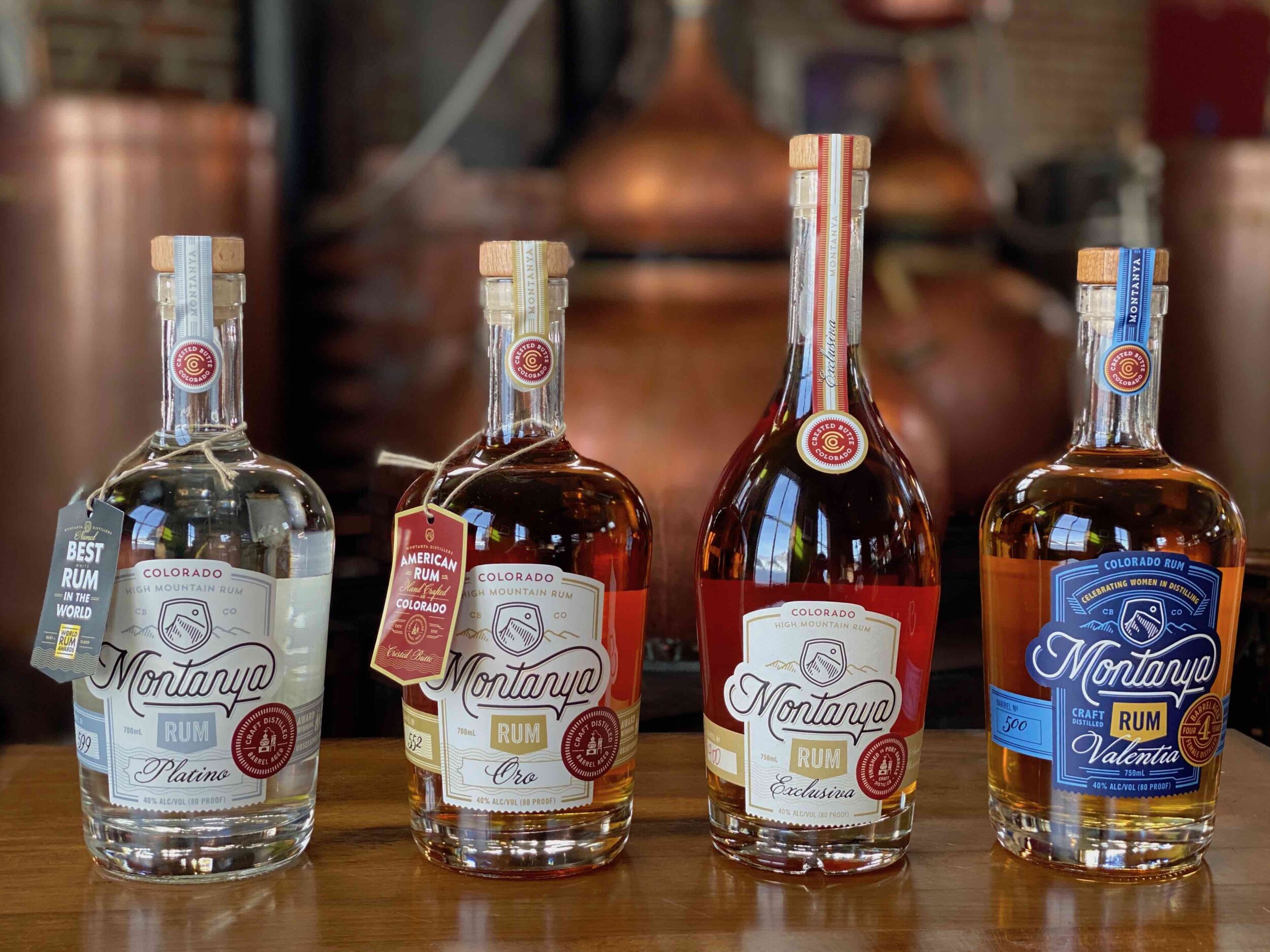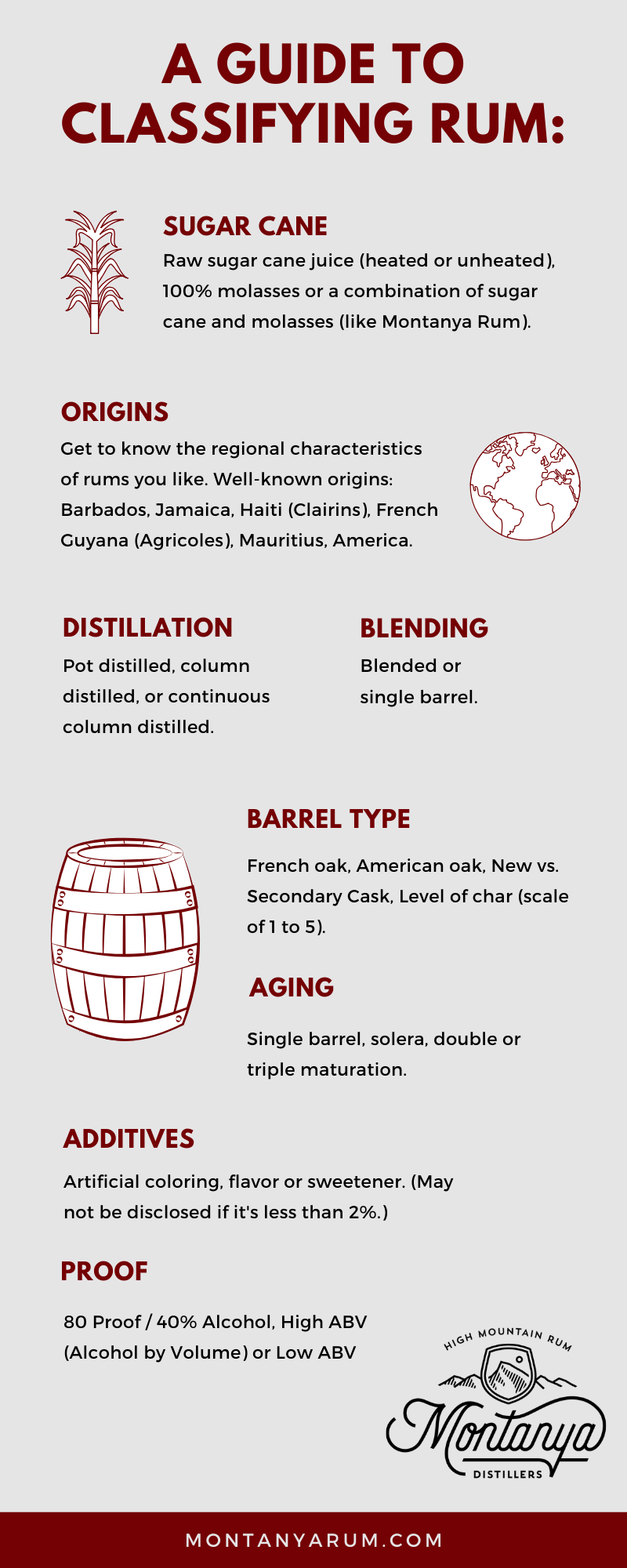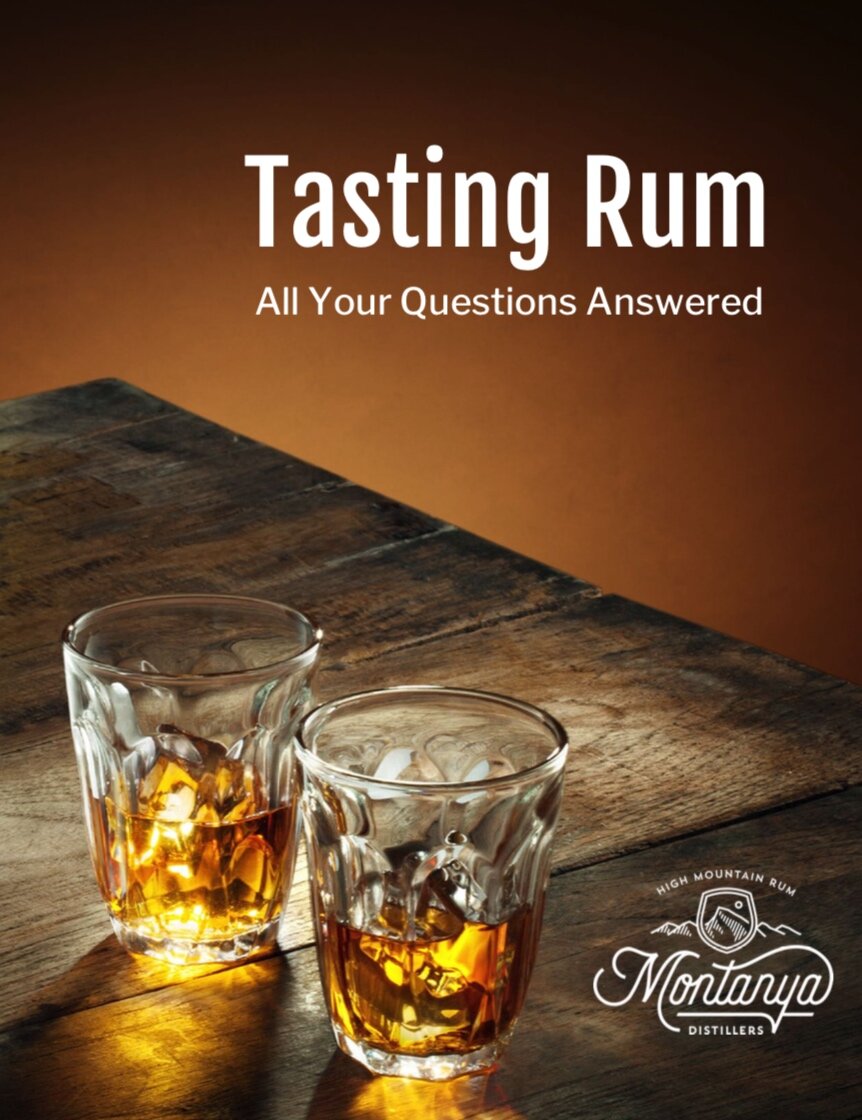A Guide to the Different Types of Rum
If you’re looking for a guide to the types of rum, you may be looking to understand how white rum is different from dark rum or what sets an aged rum apart. It sounds like a simple query, and yet understanding and classifying the different types of rum is a topic that has sparked more than one debate—er, discussion—among rum lovers.
Read on for our take on what distinguishes one rum from another. It starts with knowing what doesn’t tell you much about a rum.
First off, it’s about so much more than light vs. dark rum.
While it would be nice to have such an easy distinction between types of rum, light versus dark doesn’t tell you much about what you’re going to taste or how the rum was made. It’s not even safe to assume that all white rums are un-aged and all dark rums are aged.
Many people assume the Platino is unaged, when all Montanya Rum is aged.
Many people approach our founder and owner Karen at tasting events and ask to try the aged rum—they see a white rum and a dark rum and make the assumption that only Montanya Oro is aged. In reality, both the Oro and Montanya Platino age for more than a year. The Platino is simply run through a coconut husk carbon filter to remove the color contributed by barrel aging. (In most carbon filtration, bone is used instead of coconut husk, which takes the flavor as well as the color—this isn’t the process we use.)
So while many white rums are un-aged or may rest only in a stainless steel vat, this is not always the case. Likewise, color isn’t necessarily an indication of aging. Sometimes color comes from artificial colors and additives after distilling. It’s possible to experience a dark rum that hasn’t been aged at all.
You also have to be careful about age statements.
Another common misperception is that a rum claiming to be aged for 12 or 23 years is going to be better than a rum aged for one. Unfortunately, you can’t take all age statements at face value. It’s pretty rare for 100% of the rum in a bottle to be aged for the same amount of time (although that is true for all Montanya Rums).
One example is an aging technique called solera, where rum ages in a barrel, and after a certain amount of time, a third of the rum is removed and a younger rum added. That process is repeated over time, so that some tiny amount of the rum in the barrel may be 20 or 25 years old and some not all. For many years, consumers didn’t understand the solera method and took the age statements at face value. While solera isn’t necessarily a bad process (some delicious rums, sherries and balsamic vinegars are made this way), it’s impossible to make age statements about it.
Age statements for blended, non-solera rums can also be misleading. It is very possible that a blended rum with an age statement of, say, eight years is only reporting the oldest or the most voluminous rum in the blend, not each rum included.
One last note on age statements (And a tidbit about vodka)
Remember that distillers are not necessarily required to tell you anything about the age of rum. The only legal definition of rum according to the TTB is that it’s distilled from sugar cane and distilled to below 190 proof. A spirit that is distilled to 190 proof or above is a vodka, even if it’s made from sugar cane. (Vodka can in fact be made from anything, as long as it’s distilled to 190 proof or higher.) Some countries require their own age statements (like Puerto Rico) but they do not always refer to oak aging.
Montanya labels include the barrel number, the location of bottling and distilling, how long the rum was aged and in what type of barrel.
So if you can’t classify rum strictly by color or age statement, how can you understand different types of rum?
Karen uses a series of characteristics to evaluate rums. They serve as a nice set of questions to ask when you’re looking to understand what you might expect from a rum or what you tend to like:
What type of sugar cane is used to make the rum?
Where does the rum originate?
Is it pot distilled or column distilled?
Is the rum blended or single barrel?
Is it aged and if so, how?
What type of barrel was used for aging?
Are there additives?
What is the proof?
That might seem like a lot of information to gather, but it boils down to a simple premise: know the maker. Good advice for most of life!
A closer look at each characteristic:
Sugar Cane
This is probably the most distinguishing characteristic of rum and can vary widely from rum to rum. Rum can be made with raw sugar cane juice, molasses, or a combination of raw sugar cane and molasses, as we do at Montanya.
A rum made with raw sugar cane juice that is pressed and fermented right away is going to taste very different from a rum made with 100% molasses. Rums made with fresh sugar cane juice tend to be described as grassy (sugar cane is a grass), and you can taste flavors specific to the rum’s place of origin more clearly (terroir). Molasses, on the other hand, is such a rich base ingredient that it will likely dominate terroir. It also has a high sulfur content that carries through the distillation process (a characteristic often associated with Caribbean style rums).
In addition, some cane juices will be heated/boiled prior to fermentation (Guatemalan) while others won’t (Agricoles and Clairins). These practices affect the flavor and tend to vary by region, bringing us to the next characteristic.
Origins
Regional origins impact rum in a variety of ways, from the type of sugar cane used to the way it’s processed and even the type of still. Take agricole rums, which come out of French Guyana—the sugar cane juice will never be heated prior to fermentation. That’s very different from Guatemala, where rum distillers are legally required to distill from sugar cane syrup, which has been boiled.
Clairin rums, typically out of Haiti, provide another good example. They’re made with sugar cane juice, but that juice is very different from sugar cane juices used in the French West Indies. Clairin styles will have a lot of variation because they typically ferment with wild yeasts—yeast that exists naturally within the air rather than a strain deliberately introduced and controlled by the distiller. (Interestingly, the sugar cane for most clairins is also not machine pressed like most, but pressed by oxen circling the presses.)
It would take a whole separate post to outline the different regional styles, but the main takeaway is that the type of still, type of sugar cane, elevation at aging, humidity during aging and other regional characteristics all influence a rum. Some of this happens naturally, and some of it is regulated by formal designations called AOC’s (a French term, Appelatian D’Origine Controlee) and GI’s (Geographic Indications). Another source of friendly debate within the industry! 😆As a consumer, the best thing you can do is get to know the regional practices of the rums you enjoy.
Pot Distilled Vs. Column Distilled
Pot distilled rums tend to have more character in the distillate, leading to a richer, more robust and flavorful rum. Column distilled rums tend to be cleaner and lighter, with fewer complicated cogeners and esters (chemical constituents that lend flavors to wine and liquors). Montanya Rums take the effects of pot distilling one step further by distilling over an open flame (you can learn more about that here).
Montanya Distillers co-founder Brice Hoskin designed the base on which our stills sit and are heated over a direct flame.
Blended vs Single Barrel
Blends and Single Barrel rums are just what they sound they like, and as a consumer it’s important to understand a couple of things. First, blends tend to be easier to balance in order to create the desired flavor profile but are harder to reproduce.
Most blenders are either trying to create consistency or make limited releases that offer different characteristics. Appleton is a blended rum designed to be consistent—Appleton 12 should always taste similar. On the other hand, Foursquare Rum has released hundreds of very different limited releases. When you’re buying a blended rum, it will help to understand if it’s a brand that aims for consistency or always offers something different.
When it comes to single barrel rums, the rum is at the whim of the barrel and what the barrel previously held. As makers of single-barrel rum, we choose our barrels carefully, from partners we admire and to create consistent, flavorful rum.
TYpe of Barrel
Most aged rums are aged in secondary casks that previously held whiskey, bourbon, cognac, port or cabernet sauvignon, each of which impacts the rum differently. Some distillers are now using fresh oak, which would impart whiskey-like characteristics since whiskey is always aged in a new cask.
The degree of char in a barrel also affects flavor. As we talk about in our post The Magic and Mystery of Barrels, charring opens the barrel’s pores so the spirit can move deeper into the wood.
A new barrel at sea level in Rhode Island, for example, with a fresh char of 4 (on a scale of 1 to 5) is going to have almost none of the sweet, fruity characteristics that can be imparted by the oak because the char is so fresh. You’ll get a lot of oak and char, and that will overwhelm more subtle flavors like vanilla, sweetness, pineapple or spice.
On the opposite end of the spectrum, when a company uses the same barrel for decades—say for a solera—the barrel will contribute less and less flavor over time.
Another factor is the use of French oak versus American oak. French oak is affiliated with vinous qualities (like tannins) and flavors less associated with rum and more with wine. An American oak barrel recently impregnated with whiskey or bourbon will create finish notes of bourbon, corn or grain that are associated with rum.
At Montanya, we age primarily in whiskey barrels from Laws Whiskey House, based in Denver, Colorado.
aging
When it comes to aging, we believe there’s no right or wrong—the issue is transparency and price. We object to high priced rums that masquerade as long-aged when they actually are not. For a long time, few consumers understood what solera meant and therefore misinterpreted the age statement. Labeling can also be complicated for blends. The rums used to create the final product may be of different ages, and depending on requirements, the age statement may be the youngest rum in the mix or the oldest.
By contrast, single barrel is what it says it is—100% of the rum is the age it says, if an age statement is included (sometimes it is not). Yet it’s also helpful to know that you can have double and triple maturation, when rum is transferred from one barrel to another in its entirety (as Montanya does with the Exclusiva, Valentia and other limited releases). As a consumer, the best thing to remember is to dig deeper than the label. Get to know the company and how it makes its rums. Believe us, this research can be incredibly fun!
(On a separate note, it’s also good to remember that nobody completely understands why aging works. We understand some of the science, but not all. There’s a mystery to it that we love and would hate to analyze so much that we miss out on that magic.)
AdditiVes
Additives aren’t a new topic, but when it comes to reading labels, the important thing to remember is that up to 2% of any spirit can have unreported ingredients. If a company adds something like orange flavoring to rum, the label is only required to call it out if it accounts for more than 2% of the ingredients. (This is especially important for celiacs and people with allergies to consider. Rum never contains gluten when it comes off the stills, but additives may.)
Some of the biggest “offenders” in terms of unnamed ingredients are propylene glycol and glycerine because they give rum the fake mouth feel of an aged rum. Anything you taste the moment the rum goes into your mouth—like sweetness, cinnamon, cranberry or orange—is likely an additive.
Heavy additives will be noticeable on the front and the finish, but generally speaking, flavors that are natural to the process of making rum will be picked up on the finish. That’s after you have moved the rum around in your mouth and swallowed.
When Karen tastes rum, she expects the best rums to be alcohol forward and then layered with delicious flavors. (She also likes to remind people that it’s the second sip that really counts when you’re evaluating a rum. Learn why in our blog post How to Taste Rum.)
Proof
One final note is to pay attention to the proof, or alcohol content, of the rum you buy. Traditionally, rums are 80 Proof, or 40% alcohol by volume (ABV). There are many high proof rums, however, that are above 80 Proof. A lot of Jamaican, funky rums are, for example, high proof and high ester. Some rums are also below 80 proof, or Low ABV.
This is important to note, because if you're not accustomed to a high proof rum it can knock your socks off the first time you try one. Likewise, if you're accustomed to drinking high proof rum, an 80 Proof rum or something with even less alcohol may seem weak or like it's missing a punch.
Wondering how Montanya Rums measure up to these traits? Click here to find out. We break down each characteristic for Montanya Rum so you know exactly what to expect from our rums.
You Might Also Like:
Find the Rums You Love
Tasting is the best way to figure out what makes one rum different from another, and find the ones you love. Our free eBook sets you up to host your own tasting—including a free tasting notes template.






